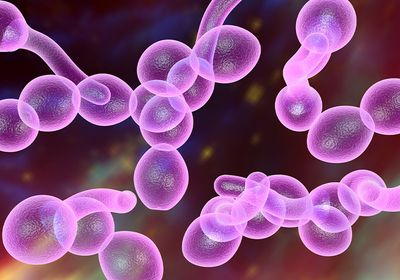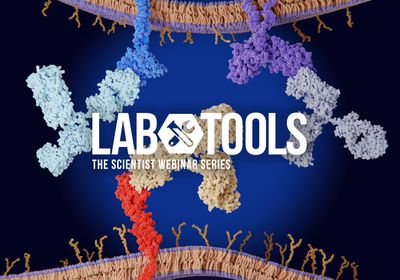ABOVE: Candida albicans is a a prevalent fungal pathogen that causes candidiasis. © iStock, Dr_Microbe
Human bodies are staunch defenders against pathogens, launching a multitude of measures to keep invaders at bay. One method of attack starves bacterial and fungal pathogens of metal ions.1 In a recent study in PLOS Pathogens, researchers reported how Candida albicans’ appetite for manganese is crucial to its pathogenicity.2
Metal ions are important for the survival of all organisms; they serve as cofactors for nearly 50 percent of all enzymes in biology.3 “If you’re an infectious microbe, you get your metals from your host. So, you’re really at the mercy of your host to get the micronutrients that you need,” explained Valeria Culotta, a molecular biologist from Johns Hopkins University and coauthor of the study.
Taking advantage of this notion, Culotta and her team investigate the influence of metal ion restrictions on C. albicans, a prevalent fungal pathogen that causes candidiasis. Her group previously found that the host modulates copper availability to control fungal growth during an infection. However, C. albicans switched between copper and manganese usage to counter the immune system’s attack.4
To understand how C. albicans accumulates manganese, Culotta’s team used CRISPR-Cas9 to knock out genes Smf12 and Smf13 to impair manganese transporter function. Without functioning transporters, depleted levels of fungal manganese decreased enzyme activity and cell wall development, demonstrating that manganese is necessary for biological and morphological aspects in yeast cells.
The researchers found that manganese fuels the same machinery that builds the cell wall and mediates the transition into the long, branching hyphal form. This finding is key because researchers attribute C. albicans’ pathogenicity, in part, to its morphological plasticity. The polymorphic fungus switches between a budding yeast form, which attaches to host cells and spreads through the bloodstream, and a filamentous hyphal form that penetrates and invades host tissues. So, unsuccessful transition to a hyphal form influences the fungus’ virulence.
To determine the extent of manganese’s role in fungal morphology, the researchers observed fungal growth. With decreased functionality of manganese transporters, the mutant fungal strains lacked sufficient levels of manganese that hindered C. albicans’ morphogenic change to its hyphal form. The researchers observed that the hyphae of Smf12 and Smf13 mutants shortened in length, and supplementing the fungi with manganese restored this defect, confirming its necessity for transitioning from budding yeast to hyphae.
Next, the researchers examined the effect of Smf12 and Smf13 mutant fungal infections in a mouse model where the kidney is the primary target tissue. They noted a 25 to 40 percent decrease in manganese levels in the kidney tissue during infection. This is the first report of whole tissue reduction of manganese as a host response and supports similar changes in the level of host metals like zinc, copper, and iron.5, 6 Without access to host manganese, the C. albicans mutants struggled to form hyphal filaments necessary for tissue invasion, and the loss in virulence contributed to increased survivability of infected mice.
“This is all part of the host trying to take these metals away from the fungus as part of the defense mechanism in the kidney environment where this manganese is dropping. C. albicans mutants that cannot obtain sufficient manganese cannot colonize, and that’s good news for the mouse,” explained Culotta.
For James Alspaugh, an infectious disease practitioner at Duke University who was not involved in the study, these findings reveal how important manganese is for survival. “When they used mutant transporters, the organism was no longer fully pathogenic. Then put it under host stress, and it just rolls over and cries ‘Uncle!’” he said.
The findings highlight the importance of manganese acquisition for C. albicans and how insufficient amounts are detrimental to its pathogenicity, laying the groundwork for further exploration. “This may be a target, or it can be something else in the manganese cellular pathway,” said Alspaugh. While manganese has been considered the forgotten metal, this work brings it to the forefront of host-pathogen interactions. Culotta’s team hopes that the role of manganese is not unique to C. albicans but extends to other fungi that are important for public health.
References
- Murdoch, CC, Skaar, EP. Nutritional immunity: the battle for nutrient metals at the host–pathogen interface. Nat Rev Microbiol. 2022;20: 657–670.
- Wildeman AS, et al. The role of manganese in morphogenesis and pathogenesis of the opportunistic fungal pathogen Candida albicans. PLoS Pathog. 2023;19(6): e1011478.
- Waldron KJ, et al. Metalloproteins and metal sensing. Nature. 2009;460(7257): 823-830.
- Li CX, et al. Candida albicans adapts to host copper during infection by swapping metal cofactors for superoxide dismutase. PNAS. 2015;112(38): E5336-E5342.
- Besold AN, et al. Role of Calprotectin in Withholding Zinc and Copper from Candida albicans. Infect Immun. 2018;86(2): e00779-17
- Haschka D, et al. Iron in immune cell function and host defense. Semin Cell Dev Biol. 2021;115:27-36








